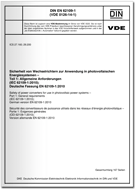DIN EN 50264-1 VDE 0260-264-1:2009-03
Railway applications – Railway rolling stock power and control cables having special fire performance
Part 1: General requirements;
German version EN 50264-1:2008
Class/Status:
Standard,
valid
Released: 2009-03
VDE Art. No.: 0260012


